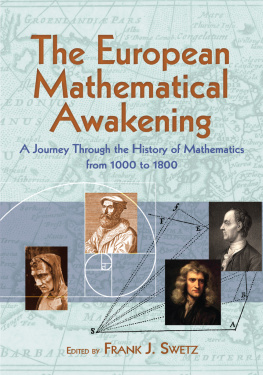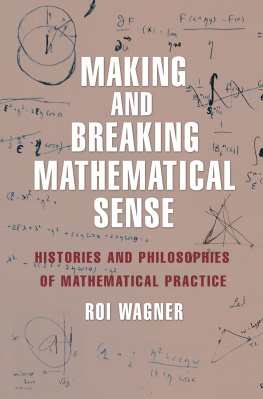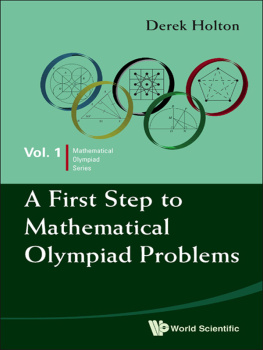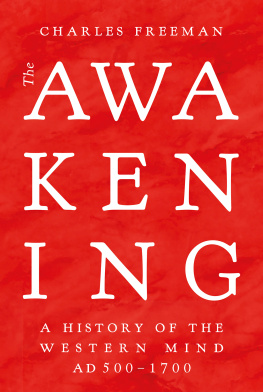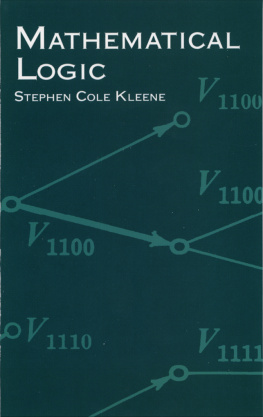Swetz - The European Mathematical Awakening
Here you can read online Swetz - The European Mathematical Awakening full text of the book (entire story) in english for free. Download pdf and epub, get meaning, cover and reviews about this ebook. year: 2013, publisher: Dover Publications, genre: Religion. Description of the work, (preface) as well as reviews are available. Best literature library LitArk.com created for fans of good reading and offers a wide selection of genres:
Romance novel
Science fiction
Adventure
Detective
Science
History
Home and family
Prose
Art
Politics
Computer
Non-fiction
Religion
Business
Children
Humor
Choose a favorite category and find really read worthwhile books. Enjoy immersion in the world of imagination, feel the emotions of the characters or learn something new for yourself, make an fascinating discovery.
The European Mathematical Awakening: summary, description and annotation
We offer to read an annotation, description, summary or preface (depends on what the author of the book "The European Mathematical Awakening" wrote himself). If you haven't found the necessary information about the book — write in the comments, we will try to find it.
Swetz: author's other books
Who wrote The European Mathematical Awakening? Find out the surname, the name of the author of the book and a list of all author's works by series.
The European Mathematical Awakening — read online for free the complete book (whole text) full work
Below is the text of the book, divided by pages. System saving the place of the last page read, allows you to conveniently read the book "The European Mathematical Awakening" online for free, without having to search again every time where you left off. Put a bookmark, and you can go to the page where you finished reading at any time.
Font size:
Interval:
Bookmark:
The European Mathematical Awakening
The European Mathematical Awakening
A Journey Through the History of Mathematics, 10001800
Edited by Frank J. Swetz
Dover Publications, Inc.
Mineola, New York
Copyright
Copyright 1994, 2013 by Frank J. Swetz
All rights reserved.
Bibliographical Note
This Dover edition, first published in 2013, contains a selection of thirty-two corrected chapters from Five Fingers to Infinity: A Journey Through the History of Mathematics, originally published in 1994 by Open Court Publishing Company, Chicago. The Preface, Epilogue, Historical Exhibit 9, Editors Notes, Bibliography, and introductory Perspectives have been specially prepared for this Dover edition by Frank J. Swetz.
Library of Congress Cataloging-in-Publication Data
From five fingers to infinity. Selections.
The European mathematical awakening: a journey through the history of mathematics, 10001800 / edited by Frank J. Swetz. Dover edition.
p. cm.
This Dover edition, first published in 2013, contains a selection of thirty-two corrected chapters From Five Fingers to Infinity: A Journey Through the History of Mathematics, originally published in 1994 by Open Court Publishing Company, Chicago
Summary: A global survey of the history of mathematics, this newly corrected and updated collection of 32 highly readable essays features contributions by such distinguished educators as Carl Boyer and Morris Kline. Fascinating articles explore studies by Fibonacci, Descartes, Cardano, Kepler, Galileo, Pascal, Newton, Euler, and others. Suitable for readers with no background in math Provided by publisher.
Summary: A history of mathematics in Europe from 1000 to 1800 Provided by publisher.
Includes bibliographical references and index.
eISBN-13: 978-0-486-31027-5
1. MathematicsEuropeHistory I. Swetz, Frank J., 1937 II. Title.
QA27.E85F76 2013
510.9dc23
2012031301
Manufactured in the United States by Courier Corporation
49805001
www.doverpublications.com
Table of Contents
The Growth of Mathematical Knowledge
VERA SANFORD
Bedes Finger Mathematics
G. A. MILLER
The Geometry of Gothic Church Windows
DOROTHY V. SCHRADER
E. R. SLEIGHT
Algorist versus the Abacist
CHARLES KING
R. B. M c CLENON
THOMAS M. SMITH
DOROTHY I. CARPENTER
PHILLIP S. JONES
RICHARD W. FELDMANN
Cardanos Technique for the Solution of a Reduced Cubic Equation
PHILLIP S.JONES
VERA SANFORD
JAMES KING BIDWELL
PHILLIP S. JONES
BERNARD H. TUCK
Multiplication Algorithms of the Fifteenth and Sixteenth Centuries
D. J. STRUIK
Mathematical Considerations on the Trajectory of a Cannon Ball
CARL B. BOYER
C. B. READ
The Evolution of Algebraic Symbolism
MORRIS KLINE
EDMOND R. KIELY
Torricellis Wine Glass
CARL B. BOYER
HAROLD MAILE BACON
Robervals Quadrature of the Cycloid
V. FREDERICK RICKEY
Newtons Method of Fluxions
DOROTHY V. SCHRADER
Mengolis Proof for the Divergence of the Harmonic Series
HOWARD EVES
WILLIAM DUNHAM
CARL B. BOYER
D. J. STRUIK
JERRY D. TAYLOR
LEO GAFNEY
Mathematicians of the French Revolution
CARL B. BOYER
TERI PERL
Women in Mathematics
Preface
T he following journey through the history of mathematics spans eight centuries, from 1000 CE to 1800 CE. This is a long period of time, which marks a turning point in European mathematical thinking, An inflection point in the graphical display of the Growth of Mathematical Knowledge as shown in Historical Exhibit 1 (p.4). It signifies a true societal awakening to the scope and power of mathematics and its applications. Other societies also experienced such intellectual transitions but their experiences will not be encountered directly during this journey. One route of understanding will be circuitous and challenging enough.
The landmarks of mathematical achievement and their relevant impact are dispersed over time and location. As your principal tour guide, I have tried to mark a meaningful travel agenda focusing on the development of mathematics and the conditions supporting that development. At each stop during the journey other tour guides, the authors of the individual articles, provide more experienced guidance to for the mathematical encounter. The route I have selected is chronologically organized so that in traversing it a reader follows the path of historical influences, the circumstances and discoveries, which gave rise to the particular event. However, each event in itself maybe visited separately, and still conveys a meaningful encounter. Historical Exhibits, snapshots, of some prominent features that reflect on the developments considered are included at relevant intervals. These Historical Exhibits are intended to provide further insights into the events visited. At each stop in our journey, further guidance is also provided by bibliographies and notes.
While the period of our intellectual journey covers 800 years, the developments in mathematics are not constrained or limited by particular intervals. Mathematical knowledge is, and has been, constantly growing. It is an ongoing process, an expression of human existence, one in which we all can participate.
FRANK J. SWETZ
Harrisburg, Pennsylvania
October, 2011
The European Mathematical Awakening
Perspective: The European Mathematical Awakening
B y the beginnings of the 11th century, Europe had survived a series of cataclysmic events: barbarian invasions; plagues and crop failures, to emerge from a period of intellectual and political stagnation known as the Dark Ages. Advances in agriculture and animal husbandry provided a better and larger food supply. Improved nutrition stimulated population increase. Land reclamation projects were undertaken and new towns founded. The harnessing of wind and water power made many of lifes daily chores easier. Opportunities in villages and towns attracted freemen, craftsmen and artisans. Road systems were improved. Trade and commerce increased. Cities grew and prospered. In particular, the Italian maritime city states of Pisa, Venice and Genoa benefited from the weakening Islamic domination of the Mediterranean to become trade entrepts for the goods and commodities of the Levant. Merchants from these cities established trading houses abroad, conducting business at the sources of their imports. Interacting with local merchants, they learned their customs and habits and brought much of this new knowledge back to Europe. Civic authority and structure were resurrected and strengthened throughout Europe, giving rise to regional and local identities, beginnings of a sense of nationalism. Trade guilds provided a united voice for some skilled working classes. These new institutions of identity and wealth gave rise to political power, which would challenge and modify existing sources of authority. Since the fall of the Roman Empire, the dominant encompassing political, as well as spiritual, authority in Europe was the Catholic Church. The Church was primarily concerned with otherworldly matters, and initially viewed inherited Greek scientific and mathematical theories as suspect pagan knowledge. However, the study of mathematics was formally sanctioned by St. Augustine (ca.400) as worthy of Christian involvement; still, the Catholic Churchs actual interest with mathematics was minimal, limited primarily to the determination of the Church calendar based on a correct dating of Easter. Handbooks called computi were written to assist in this task. A few churchmen pursued mathematics for its intrinsic and classical values. One such scholar was the French monk, Gerbert of Aurillac (ca. 9501003), who eventually became Pope Sylvester II in the year 999. Gerbert sought out existing Arabic sources of Euclids
Next pageFont size:
Interval:
Bookmark:
Similar books «The European Mathematical Awakening»
Look at similar books to The European Mathematical Awakening. We have selected literature similar in name and meaning in the hope of providing readers with more options to find new, interesting, not yet read works.
Discussion, reviews of the book The European Mathematical Awakening and just readers' own opinions. Leave your comments, write what you think about the work, its meaning or the main characters. Specify what exactly you liked and what you didn't like, and why you think so.

